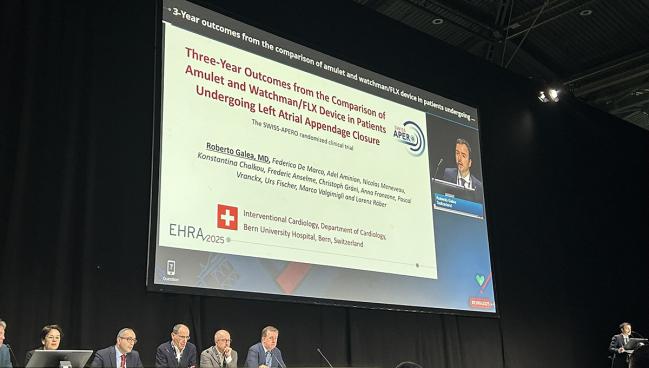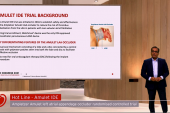SWISS-APERO at 3 Years: Hints of Differences Between Amulet, Watchman Emerge
Though ischemic outcomes numerically favored the Amulet, confirmation in future studies is needed, experts say.

VIENNA, Austria—There may be potential differences in ischemic outcomes between the two most frequently used devices for left atrial appendage occlusion (LAAO) in patients with atrial fibrillation (AF), according to follow-up data from the SWISS-APERO study.
At 3 years, the rate of cardiovascular death, stroke, TIA, or systemic embolism was 18.2% among patients with appendages closed with the Amplatzer Amulet (Abbott) and 31.0% among those treated with the Watchman 2.5 or Watchman FLX device (Boston Scientific).
The results fell shy of statistical significance in an intention-to-treat analysis (HR 0.58; 95% CI 0.33-1.03) but was significant in as-treated and per-protocol analyses, a difference largely driven by less cardiovascular mortality with Amulet, Roberto Galea, MD (Bern University Hospital, Switzerland), reported last week at the European Heart Rhythm Association (EHRA) Congress 2025.
Galea acknowledged several limitations of the study, however, including that the trial was not powered to detect differences in clinical outcomes.
“Longer follow-up and more comparative studies are needed to confirm potential differences in ischemic outcomes between the two devices,” he concluded.
Though it’s valuable to have randomized data comparing two LAAO devices, these should be considered hypothesis-generating results given the limitations, Manesh Patel, MD (Duke Clinical Research Institute, Durham, NC), commented to TCTMD.
“These devices are an important option for our patients,” Patel said. “I’m not sure, even though this is an important trial, based on these 3-year data, that I know that one device is clearly better than the other . . . because I’m not sure how modifiable cardiovascular death is in this population. So, I don’t know if this is just play of chance.”
Because of the uncertainties, “I’d like to see these signals reproduced again,” he said.
The findings were published in the Journal of the American College of Cardiology.
The SWISS-APERO Trial
Both the AMULET IDE trial and SWISS-APERO compared the Amulet device with the Watchman. Both trials pointed to fewer peridevice leaks with the Amulet—as measured by transesophageal echocardiography at 45 days in SWISS-APERO and at 1 year in AMULET IDE. In SWISS-APERO, CT-assessed leak rates were similar with both devices at 1 year.
When AMULET IDE investigators extended follow-up out to 3 years, they found no significant differences in clinical outcomes when comparing the Amulet with the older Watchman 2.5 device.
At the EHRA meeting, Galea reported outcomes of SWISS-APERO at the same time point. Of the 221 patients (mean age 77 years; 71% men) included in the trial, about 40% had a prior cerebrovascular event and nearly 90% had a history of relevant bleeding. Of note, 23% of patients in the Watchman arm of the trial were treated with the Watchman 2.5 device because the newer Watchman FLX was not yet available.
Use of antithrombotic therapy was similar in both arms through 3 years of follow-up, with about 70% of patients discharged on dual antiplatelet therapy (DAPT). At 45 days, roughly 45% were still on DAPT and another 45% were on a single antiplatelet. At 1 and 3 years, about 65% of patients were on single antiplatelet therapy.
In the intention-to-treat analysis, there were no significant differences in clinical outcomes between trial arms, although event rates were numerically lower in the Amulet-treated patients. Major bleeding (BARC type 3-5) occurred at similar rates in the two arms (16.5% with Amulet vs 18.0% with Watchman 2.5/FLX; HR 1.03; 95% CI 0.53-1.97).
In an as-treated analysis, the rate of cardiovascular death, stroke, TIA, or systemic embolism was significantly lower in the Amulet arm (17.0% vs 31.1%; HR 0.53; 95% CI 0.30-0.96), driven by a 50% lower risk of cardiovascular death (12.1% vs 23.7%; HR 0.50; 95% CI 0.25-0.99). A per-protocol analysis yielded similar results.
There were no differences between the Amulet and Watchman groups at 3 years in device-related complications, including device-related thrombus (3.6% vs 6.4%; risk ratio 0.57; 95% CI 0.17-1.88) and peridevice leak (35.1% vs 42.7%; risk ratio 0.82; 95% CI 0.59-1.15).
Hypothesis-Generating Results
Galea acknowledged the composite ischemic endpoint explored in the current analysis was not prespecified. Also, a “relevant percentage” of patients—about 27%—died by 3 years, indicative of the high-risk population that was enrolled. Another limitation is that more than one-fifth of the participants in the Watchman arm were treated with the earlier-generation device and follow-up assessments were not completely blinded since the two occluders could be easily distinguished on CT, he added.
To TCTMD, Patel said the difference in ischemic outcomes driven by a lower rate of cardiovascular death in the Amulet arm is an important finding, but a potential mechanism explaining it is unclear. He indicated that the numerically lower number of strokes in the Amulet arm would not be enough to explain the disparity in cardiovascular death.
Oussama Wazni, MD (Cleveland Clinic, OH), who discussed the results following Galea’s presentation, also focused on the limitations of the analysis, particularly the mix of devices used in the Watchman arm, the fact that Watchman patients did not routinely receive 45 days of oral anticoagulation after the procedure (as was recommended on the label at the time), and the large number of patients who died within 3 years.
He also questioned the plausibility of the difference in cardiovascular death observed between the two trial arms and pointed to the lack of statistical power for assessing differences in clinical outcomes.
“It’s very hard for me to come up with any definite conclusions from this study,” Wazni said.
Galea responded to some of Wazni’s critiques and said, “The most important thing is to design an adequately powered randomized clinical trial between the two devices in order to give a definitive answer.”
Todd Neale is the Associate News Editor for TCTMD and a Senior Medical Journalist. He got his start in journalism at …
Read Full BioSources
Galea R. Three-year outcomes from the comparison of Amulet and Watchman/FLX device in patients undergoing left atrial appendage closure: the SWISS-APERO randomized clinical trial. Presented at: EHRA 2025. April 1, 2025. Vienna, Austria.
Disclosures
- Galea reports receiving a research grant from the Swiss Heart Foundation, receiving speaking honoraria from Boston Scientific, and serving as a proctor and consultant for Abbott.





Comments